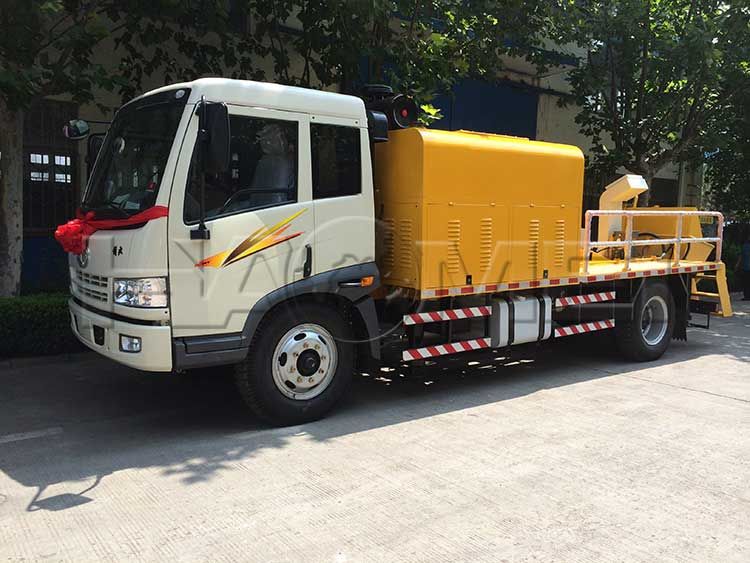Truck-Mounted Concrete Line Pumps Vs Concrete Spray Pump
Posted On: 27/11/2025 | Posted by: Haomei Concrete Pumps
In the field of concrete construction, "pumping equipment" is a core component for improving efficiency, but many people confuse truck-mounted concrete line pumps with concrete spray pumps. The former is a "precision deliveryman," while the latter is an "efficient wall builder," and the two differ fundamentally in principle, performance, and application.

Core Positioning: Conveying "Delivery" vs. Spraying "Shaping"
The fundamental difference between the two types of equipment lies in their different concrete processing goals—truck-mounted pumps focus on "long-distance, high-altitude delivery," ensuring concrete accurately reaches the pouring point; spray pumps, on the other hand, focus on "high-speed spraying and adhesion," allowing concrete to form directly on the work surface without the need for traditional formwork.
Truck-mounted pumps are "mobile delivery stations," integrating the concrete pumping mechanism onto a truck chassis, combining driving and pumping functions, and enabling rapid relocation between multiple construction sites.
Their task is to smoothly transport concrete from the mixing plant to pouring locations such as high-rise building floor slabs and bridge piers, essentially acting as a "transportation relay baton" for concrete.
A spray pump is a "site forming machine" that uses high pressure to spray concrete mixture at high speed onto working surfaces such as rocks and tunnel walls, utilizing the impact energy and setting properties of concrete to form a support layer or structural layer.
In scenarios where formwork is difficult, such as underground roadways and tunnel support, it can directly complete the integrated operation of "transportation + forming," making it a "protective expert" in geotechnical engineering.
Working Principle: Mechanical Push vs. High-Pressure Spraying
The difference in principle determines the core performance of the two and directly affects the construction effect. We can compare them from two perspectives: power transmission and concrete processing methods:
1. Truck-mounted concrete pump: Hydraulically driven "reciprocating push"
Its core is a "dual-cylinder reciprocating pumping system": the engine drives a hydraulic pump to generate high-pressure oil, which drives two main cylinders to alternately operate. Through the orderly switching of the S valve, concrete in the hopper is continuously sucked into the conveying cylinder and then pressed into the conveying pipeline to the target point. This principle is similar to "syringe injection," emphasizing the continuity and stability of delivery.
In terms of power type, truck-mounted concrete pumps are divided into power-shared types (single engine switching between driving and pumping) and power-separated types (dual engines each responsible for pumping). The former has a compact structure, while the latter extends the life of the chassis and engine; the choice can be made according to working conditions.
2. Concrete Shotcrete Pump: A "High-Speed Jet" of Energy Conversion
Its core is a "high-pressure acceleration system," which comes in two technical paths: dry and wet. Dry shotcrete machines use compressed air to mix dry materials with water at the spray gun before spraying; wet shotcrete machines directly deliver pre-mixed wet concrete, adding an accelerator at the nozzle before high-speed spraying.
Essentially, the shotcrete pump utilizes the energy of the working fluid (compressed air or hydraulic energy) to transform concrete from "low-speed delivery" to a "high-speed jet" (exit velocity can reach tens of meters per second). The impact force allows the concrete to adhere tightly to the working surface, while the accelerator precisely controls the setting time, reducing rebound waste.
Key Performance: Parameter Differences Determine Applicable Scenarios
The core of engineering selection is matching performance parameters with construction needs. We compare the two based on five key indicators:
1. Conveying Capacity
Truck-mounted pumps prioritize "large displacement and high lift," with mainstream displacements reaching 120 m³/h and maximum pumping heights up to 250 m, suitable for large-volume pouring in high-rise buildings, cross-river bridges, and other similar projects. Its advantage is continuous, uninterrupted delivery, matching the feeding speed of concrete mixer trucks. This is same with the tower concrete pump.
Concrete spray pumps emphasize "precise spray volume," with relatively lower displacements (typically 20-50 m³/h), but has very low rebound rate (wet shotcrete rebound rate can be below 10%). Combined with a precise accelerator addition system, material loss can be effectively controlled.
2. Operating Environment
Truck-mounted pumps rely on a truck chassis, eliminating the need for trailers during relocation. They can quickly adapt to urban construction sites, suburban roads, and other scenarios. Four independent hydraulic outriggers ensure stability on complex terrain. However, it has certain site requirements, needing to reserve space for outrigger deployment.
Spray pumps (especially mining types) have a compact structure and small size, adaptable to narrow spaces such as underground roadways and tunnels with heights of 2.5-7m. They have a climbing ability of up to 30% and, with wired/wireless remote control operation, can operate flexibly in harsh environments. However, their relocation usually requires auxiliary transportation.
3. Concrete Requirements
Truck-mounted pumps are highly adaptable to different types of concrete. As long as the slump meets the standard requirements (10-20cm), no special modification is needed; they can transport ordinary ready-mixed concrete.
Shotcrete pumps (especially wet-type) have higher requirements for concrete workability. The slump needs to be controlled at 15-20cm, and the aggregate gradation must be precise to avoid pipe blockage. They also need to be used with a quick-setting agent to ensure rapid setting and shaping after spraying.
4. Environmental Protection and Safety
The vehicle-mounted pump features an optimized hydraulic system, resulting in less reversing impact and lower operating noise. Some models are equipped with an intelligent fault self-diagnosis system that can monitor over 120 faults in real time, enhancing safety.
The environmental advantages of the spray pump lie in its wet spraying technology. Compared to dry spraying, it significantly reduces dust, improving the working environment in confined spaces such as mines and tunnels. Furthermore, its absence of mechanical transmission components makes it safer when handling special materials.
Original source: https://www.concrete-pump-cn.com/a/truck-mounted-concrete-line-pumps-vs-concrete-spray-pump.html
Tags: concrete pump trailer,
Previous: HBTS50 Concrete Trailer Pump To Oman
Next:


 feedom@haomei-machinery.com
feedom@haomei-machinery.com